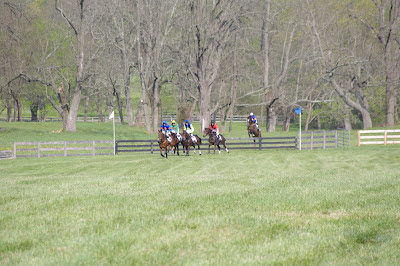This isn't your average horse race. The horses, averaging 10-13 years old race over 22 fences, 4 board and 18 rail, ranging in height from 2'11" at the water jump to 4'10" at the number 16 fence. And that is it, one race! It is an entire afternoon spent picnicking and tailgating in anticipation of that single race. The only vendors present are selling the race program and race caps and t-shirts. There is no other commercial activity and no commercial advertising present anywhere. How many other horse racing events are only based around one race? And how many major sporting events are still void of corporate sponsorships? I can't think of anywhere else I'd rather be on the last Saturday in April.
13th Fence at the 2012 Maryland Hunt Cup
The Maryland Hunt Cup began in 1894 when the members of the Elkridge Hunt challenged members of Green Spring Valley Hunt to a timber race on Dr. William Lee's property near Stevenson Station in the Green Spring Valley and heading east finishing near George Brown's race track at Brooklandwood, a distance of 4 miles. The first race was limited to members of those two clubs, but the next year the race was opened to members of any fox hunt in Maryland. In 1903, members from recognized hunts throughout the United States and Canada were invited to participate.
In 1895 the race began at Hampton Gate on Dulaney Valley Road, a mile north of Towson, and ran over a circular course of about 4 1/8 miles. The following year the race returned to the Green spring Valley, starting at Brooklandwood and running a distance of a little less than 5 miles. It remained in that area one last time in 1897, starting in a field directly north of Brooklandville Station on the east side of Falls Road.
In 1898 the race moved near Cockeysville, starting and ending at Gerar, the country home of E. Gittings Merryman and the following year to “Long Green,” the country seat of W.S.G. Williams. The house at Gerar was demolished by 1962 to make way for Marriott's Hunt Valley Inn, with the remainder of the property becoming part of the Hunt Valley Industrial Park. Long Green would become part of the Deford/Boordy Vineyard Estate.
The race returned to the Green Spring Valley in 1900 and 1901 before moving to R.M. Dennison’s farm, Salona in Timonium in 1902. Then in 1903, the race started 1/4 mile north of Towson, directly east of York Road, and finishing at Hampton. In 1904, the Hunt cup returned for one last run in the Green Spring Valley, site of its birth ten years earlier, where it remained through 1914, running over a number of owners properties.
In 1915, the Hunt Cup left the Green Spring Valley for good, never to return. That year it was run for the first time in the Worthington Valley, starting and finishing at Merberne Manor Farm, the home of G. Bernard Fenwick, where it remained through 1918. Since the Fenwick Farm was entirely fenced in wire, the race committee had to build panel fences in order to run the race.
With the Fenwick Farm being planted in corn in 1919, the race moved back to Hampton in Dulaney Valley for two years before moving to Five Farms, country home of Stuart Oliver, for the 1921 race, the last race to be run outside Worthington Valley.
Finish Line at the 2012 Maryland Hunt Cup
In 1922, the Hunt Cup returned to the Worthington Valley and Snow Hill, the home of Charles L.A. Heiser, and the present Hunt Cup course. Since that time, the course has remained fixed, with only the names of the property owners changing over the years.
The present course was originally laid out by G. Bernard Fenwick and Thomas Disney and has stood the test of time, still providing perhaps the most challenging and well known steeplechase course on either side of the Atlantic. It is this race, and this race alone which receives regular mention in British Steeplechase racing circuits and for good reason.
There are three different parking options for spectators and everyone has their favorite vantage point, from any of the 22 jumps, to the hillside overlooking the course or the final dash for the finish. If you plan things well, you can even see multiple jumps and the finish line up close. And while this race is clearly the dressiest of all the Maryland timber races, spectators for this races, like all the races, are well advised to first dress for the weather and then to dress for fashion.
So the last Saturday in April each year, I make the trek to Worthington Valley to join my friends and many strangers and watch one of the greatest spectacles in Steeplechase racing. I wouldn't have it any other way!
All Rights Reserved.







